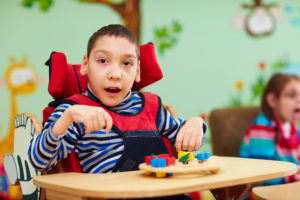Birth Injury Lawyer’s Guide for Families With Cerebral Palsy
Our cerebral palsy law firm in Oregon knows that new parents think about many things. How healthy is my child? Is my child receiving the best care possible? My child is about to reach a significant milestone. When will he learn to walk, talk, or crawl? The child is a usual question, but if the milestones are not being met, then things get more complicated. Children can struggle with a wide range of developmental issues, but cerebral palsy is more severe. Each child and their family may be affected differently by cerebral palsy, a general pathology. Our birth injury lawyers have developed a cerebral palsy family guide for this reason.
This family guide was created to help answer all of the common questions surrounding a cerebral palsy diagnosis. The guide was designed to provide an overview of cerebral palsy and the common questions about the causes, types, treatment, prevalence, complications, and how it can affect the future of your child and family. The guide is not a replacement for medical advice from a doctor. If you believe something is wrong with your child, then seek out medical care from a doctor who has the means to evaluate your child. Do not use this guide to diagnose your child.
The most important thing to stress is that, if you believe that your loved one was the victim of medical malpractice and birth injuries, call our cerebral palsy law firm in Oregon to learn how we can help you recover compensation. We offer FREE case reviews and can help ensure that your rights are well protected under Oregon law.
What is Cerebral Palsy?
It is essential to know what cerebral palsy is and how it occurs to understand it. Cerebral palsy is defined as follows by the Centers for Disease Control and Prevention (CDC):
People with cerebral palsy (CP) exhibit difficulty moving, maintaining balance, and maintaining good posture. Children with CP are most likely to have motor disabilities. The term cerebral refers to something related to the brain. The term palsy refers to weakness or difficulty using the muscles. People with CP have irregular brain development or damage to their developing brain that affects their muscles’ ability to control.
This damage is often permanent and can appear immediately after birth or might be detected only years down the road. Cerebral palsy children are often unable to perform movements and postures that healthy children are capable of. Depending on the severity of the pathology, cerebral palsy can also affect cognition or intelligence.
The Prevalence of Cerebral Palsy
Many research studies have been conducted globally regarding cerebral palsy. In the United States, there are between 1.4 and 4 children with cerebral palsy for every 1000 live births, according to worldwide data. According to studies conducted in the US, the rate varies from 3.1 to 3.6 per 1,000 live births.
In addition, studies have been conducted on how these children function, specifically when it comes to walking. According to a study of 8-year-olds with cerebral palsy, 30% had severely limited or no walking ability, while 58% could walk independently. The prevalence of epilepsy in children with cerebral palsy is higher than that of autism spectrum disorder in those with the disorder.
Contributing Factors for Cerebral Palsy
A variety of factors causes cerebral palsy, but a lack of oxygen to the brain is the most common. Cerebral palsy is most commonly caused before birth and is referred to as congenital cerebral palsy. When cerebral palsy is acquired after birth, it is referred to as acquired cerebral palsy.
Congenital cerebral palsy is not fully understood, but some risk factors have been found. Included are:
- Low birthweight- Children born less than 5.5 pounds, especially those who weighed less than 3 pounds 5 ounces, have a higher risk.
- Prematurity – If a child is born before week 37 of pregnancy, they are at high risk, while if they are born before 32 weeks, they are more likely to have cerebral palsy.
- It has been shown that giving birth to twins, triplets, or other multiples is a risk factor, especially if one or more babies are stillborn.
- The use of assisted reproductive technologies infertility treatments – These types of pregnancies is more likely to result in premature births or multiple births, both of which are associated with cerebral palsy.
- Pregnancy infection – Infections may affect the unborn child by causing inflammation and brain damage. Infections of the placenta or fetal membranes due to bacteria, including chickenpox, rubella, and cytomegalovirus, are linked to cerebral palsy.
- Kernicterus and jaundice are conditions in which the baby’s blood becomes yellow because of an excess of a chemical called bilirubin. The condition kernicterus can cause cerebral palsy and other medical conditions in cases of severe jaundice.
- Having a child with cerebral palsy is more likely to occur if the mother has thyroid disease, intellectual disability, or seizures
- Several birth complications can result in cerebral palsy, such as the placenta detaching, a problem with the umbilical cord decreasing the supply of blood to the baby, or a uterine rupture.
The condition is known as acquired cerebral palsy, when brain damage occurs 28 days after birth. There are usually various causes of acquired cerebral palsy, such as conditions that cause damage to the head (such as a car accident or child abuse), conditions that lead to brain infections (such as encephalitis or meningitis), and problems with the blood supply to the brain (like strokes or bleeding in the brain that heart defects may cause, heart defects, abnormal blood vessel formation, or abnormal blood clotting).
Medical Malpractice in Oregon Causing Cerebral Palsy
Cerebral palsy is caused by medical malpractice, which can occur before, during, or after birth. Although the exact causes of cerebral palsy remain unclear, a few specific factors can contribute to the condition. Medical malpractice in Oregon may have caused cerebral palsy due to several factors such as:
- Infections that are not detected or treated properly
- Inappropriate use of delivery tools
- C-sections not performed promptly
- Umbilical cord prolapse due to a failure to detect it
- Inability to secure an airway
- Relative delays when performing resuscitations
- Prolonged contractions
- Overdoses of Pitocin
- Delayed C-section
- Failure to diagnose and treat a hypoxic or anoxic condition
Medical malpractice may result in severe injuries and life-long complications for a child in any of these cases. Knowing this specialized field, our Oregon medical malpractice lawyers can help determine if malpractice occurred. Always call our cerebral palsy law firm in Oregon for help to learn what your rights to compensation may be.
Cerebral Palsy Types
The type of movement pattern displayed by the child determines cerebral palsy. Generally, doctors look for signs of spasticity, dyskinesia, and ataxia. Spasticity refers to tight, stiff muscles that can cause trouble with standard movement patterns. In dyskinesia, muscles contract and move involuntarily. Ataxia is a condition characterized by difficulty in coordinating movements. According to these terms, cerebral palsy can be classified into four major categories:
- Mixed
- Spastic
- Ataxic
- Dyskinetic
It is our goal to identify these kinds of cerebral palsy in this guide. A guide for the cerebral palsy types will be published at a later time. Among the differences between the various types are the following:
Dyskinetic Cerebral Palsy
Due to dyskinetic cerebral palsy, the child’s ability to move their legs, arms, hands, and feet. During the day, the level of muscle tone can change from flaccid (low or limp) to spastic (high or weak, similar to spastic cerebral palsy). Dyskinetic cerebral palsy is a progressive neurological condition that causes uncontrollable, jerky, and writhing movements. Eating, drinking, and speaking are among the primary activities they have difficulty with.
Spastic Cerebral Palsy
There are three subtypes of spastic cerebral palsy based on which body parts are affected. Spastic cerebral palsy makes up the majority of cases. It is known as spastic diplegia when only the legs of the child are affected. These children usually struggle to walk because the muscles in their legs are so tight. Regardless of how the tightness changes over time, it is usually present in one form or another. During the gait pattern of these children, their legs are often pulled inwards, and they cross each other. This is called the scissoring gait.
The condition is termed spastic hemiplegia when it only affects one side of the body. Both left and right arms and legs can be affected, but the arm is often more affected than the leg. These children often have difficulty using their affected arm for everyday activities, such as dressing, playing, and feeding.
Spastic quadriplegia is the most severe subcategory. The arms, legs, trunk, and face are all affected. The children usually need a wheelchair and are intellectually disabled. For even simple tasks such as dressing and feeding, these children require the utmost care and attention.
Ataxic Cerebral Palsy
There is another type of cerebral palsy known as ataxic cerebral palsy. A cerebellum-related disorder usually occurs when the brain’s cerebellum is damaged. To produce smooth, fluid movements, the cerebellum regulates movement signals coming from everywhere in the nervous system. It leads to difficulty writing, reaching for objects, walking, and running when it is damaged.
Mixed Cerebral Palsy
There is also a type of cerebral palsy known as mixed cerebral palsy, which includes children who exhibit characteristics of more than one type and therefore do not fit into any one category. Depending on their presentation, it may be possible to categorize children as having two or three specific forms of cerebral palsy, with nonspastic-dyskinetic cerebral palsy being the most common type. If your child has this type of cerebral palsy or any other, call our cerebral palsy law firm in Oregon for help.
Cerebral Palsy Treatment
The goal of cerebral palsy treatment is to restore function to the affected limbs to normal function as possible. In some cases, medication such as baclofen may make movement easier by decreasing muscle spasticity. Treatment usually includes both medication for controlling spasticity (if it is a problem) and rehabilitative therapies to produce the best results.
Surgical procedures can help mitigate symptoms for children with severe symptoms. A surgically implanted baclofen pump can administer medication to control spasticity in children undergoing physical therapy. It is possible to lengthen tight or spastic muscles in some cases by performing muscle and tendon lengthening procedures. Both the child and their family may experience pain and anxiety during these surgeries.
Rehabilitation therapies such as occupational therapy and physical therapy play a significant role in the treatment. Physical and occupational therapy aims to improve strength, flexibility, and range of motion to improve movement patterns; speech therapy treats the speech disorders associated with cerebral palsy, such as issues with facial muscle control and developmental delays.
The therapies for these conditions are usually introduced to children at a young age. Children receive this care as soon as they are born and through their childhood, even though their adult years are necessary. During therapy, it is expected that families will take a proactive role and perform exercises and stretches each day.
Children with cerebral palsy can take advantage of a variety of school-based resources. In some cases, children with cerebral palsy may attend mainstream schools, while others may attend specialized schools for children with autism, Down syndrome, and other developmental disorders. To help identify future resources that you may need, you can use this cerebral palsy family guide.
Life with Cerebral Palsy: Complications and Implications
Eventually, you might begin to consider the long-term effects your child’s cerebral palsy will have on their life, as well as yours. In the United States, an adult with cerebral palsy will have lifetime costs exceeding $1.3 million. A child with cerebral palsy will require frequent appointments with the doctor to monitor their progress throughout the early years following diagnosis.
As the severity of the symptoms increases, the child will require specialized equipment. Foot and ankle braces, hand braces, and walkers are relatively inexpensive. Still, power wheelchairs and home modifications (such as ramps, stairs with chairlifts, access to the house through ramps, and wheelchair-adaptable cars) are much more expensive.
Those costs alone can reach tens of thousands of dollars and result in severe financial hardship. As a result of the severity of the child’s condition, they may not go to public school. They will need a range of physical, occupational, and speech therapies. There is no escaping the emotional burden placed on the parents, families, and other caregivers. Care for a child with cerebral palsy can place a considerable emotional and financial strain on a family.
How Our CP Lawyers Can Help You in Oregon
If your loved one was diagnosed with CP, call our cerebral palsy law firm in Oregon for help. We offer victims and their families many options during our representation. This includes offer FREE consultations. This means that we will review your case for free to hear what happened to you, what your child’s injuries are, and why you think a doctor may have harmed you. We will hear who your providers were and what they did, and learn about the disabilities your children have.
If we agree to accept your case, we will sign a retainer agreement and investigate what happened. This includes having a physician review your medical records and your child’s medical records. This may include a full evaluation of what happened, including more questions regarding your child’s physical traits, ability, and developmental progression. Our expert may want to speak with you, or we may ask you questions or send a questionnaire. This is done to learn more about your case and determine whether there is liability. This is often the most hotly contested part of any medical malpractice case, and our cerebral palsy law firm in Oregon strongly prepares for these types of cases.
We will do this, including paying the upfront costs and disbursements, litigation expenses, court fees, expert expenses, medical record fees, and other costs at our expense. These fees are only reimbursed if we recover compensation for you in a settlement, verdict, or other award.
The same is true of our attorneys’ fees which are also only reimbursed after we recover compensation for you in a settlement, verdict, or award. By doing this, there is a no-cost guarantee. This means if we do not recover compensation in your lawsuit you do not owe us any more. A no win, no fee guarantee is the best way to have a lawyer handle your CP case or birth injury matter without risking money out of your pocket. We are only paid a percentage of what we recover for you too, meaning there is no out-of-pocket expense.
Call Our Cerebral Palsy Law Firm in Oregon for Help With Your Case
If you or a loved one have been seriously injured or killed as a result of medical malpractice contact the Oregon Medical Malpractice Lawyers at Kuhlman Law at our number below or fill out the intake form. We offer a free initial case evaluation and handle cases on a contingency fee which means that you pay no money unless we recover.
Our law firm handles cases throughout the state including Bend and Portland Oregon, Redmond, Central Oregon, Sisters, Madras, Multnomah County, Deschutes County, Salem, Eugene, Corvallis, Lane County, Medford, Gresham, La Grande, Albany, Medford, Beaverton, Umatilla, Pendleton, Cottage Grove, Florence, Oregon City, Springfield, Keizer, Grants Pass, McMinnville, Tualatin, West Linn, Forest Grove, Wilsonville, Newberg, Roseburg, Lake Oswego, Klamath Falls, Happy Valley, Tigard, Ashland, Milwakie, Coos Bay, The Dalles, St. Helens, Sherwood, Central Point, Canby, Troutdale, Hermiston, Silverton, Hood River, Newport, Prineville, Astoria, Tillamook, Lincoln City, Hillsboro, and Vancouver, Washington.
We also have an office in Minneapolis, Minnesota and take medical malpractice cases throughout the Twin Cities, including St. Paul, Hennepin County, Ramsey County, Dakota County, Washington County, Anoka County, Scott County, Blaine, Stillwater, and Saint Paul Minnesota.




